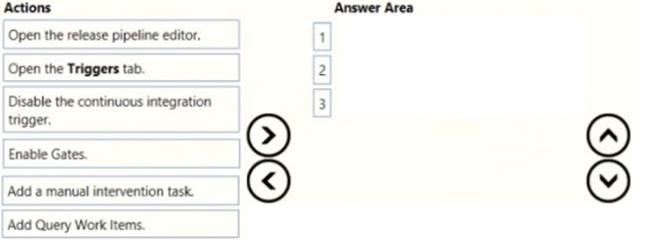- (Topic 4)
You have an Azure Resource Manager template that deploys a multi-tier application.
You need to prevent the user who performs the deployment from viewing the account credentials and connection strings used by the application.
What should you use?
Correct Answer:
D
When you need to pass a secure value (like a password) as a parameter during deployment, you can retrieve the value from an Azure Key Vault. You retrieve the value by referencing the key vault and secret in your parameter file. The value is never exposed because you only reference its key vault ID. The key vault can exist in a different subscription than the resource group you are deploying to.
References: https://docs.microsoft.com/en-us/azure/azure-resource-manager/resource-manager-keyvault-parameter
DRAG DROP - (Topic 2)
You need to implement Project6.
Which three actions should you perform in sequence? To answer, move the appropriate actions from the list of actions to the answer area and arrange them m the correct order.
Solution:
Scenario: Implement Project3, Project5, Project6, and Project7 based on the planned changes
Step 1: Open the release pipeline editor.
In the Releases tab of Azure Pipelines, select your release pipeline and choose Edit to open the pipeline editor.
Step 2: Enable Gates.
Choose the pre-deployment conditions icon for the Production stage to open the conditions panel. Enable gates by using the switch control in the Gates section.
Step 3: Add Query Work items.
Choose + Add and select the Query Work Items gate. Configure the gate by selecting an existing work item query.
Note: A case for release gate is:
Incident and issues management. Ensure the required status for work items, incidents, and issues. For example, ensure deployment occurs only if no priority zero bugs exist, and validation that there are no active incidents takes place after deployment.
References:
https://docs.microsoft.com/en-us/azure/devops/pipelines/release/deploy-using- approvals?view=azure-devops#configure-gate
Does this meet the goal?
Correct Answer:
A
- (Topic 4)
Note: This question is part of a series of questions that present the same scenario. Each question in the series contains a unique solution that might meet the stated goals. Some question sets might have more than one correct solution, while others might not have a correct solution.
After you answer a question in this section, you will NOT be able to return to it. As a result, these questions will not appear in the review screen.
You need to recommend an integration strategy for the build process of a Java application. The solution must meet the following requirements:
✑ The builds must access an on-premises dependency management system.
✑ The build outputs must be stored as Server artifacts in Azure DevOps.
✑ The source code must be stored in a Git repository in Azure DevOps.
Solution: Install and configure a self-hosted build agent on an on-premises machine. Configure the build pipeline to use the Default agent pool. Include the Java Tool Installer task in the build pipeline.
Does this meet the goal?
Correct Answer:
A
Instead use Octopus Tentacle.
References:
https://explore.emtecinc.com/blog/octopus-for-automated-deployment-in-devops-models
- (Topic 4)
You have a multi-tier application. The front end of the application is hosted in Azure App Service. You need to identify the average load times of the application pages. What should you use?
Correct Answer:
B
- (Topic 4)
You use Calendar Versioning (CalVer) for code assets.
You need to store an optional tag of beta as part of the version. Which part of the version should you use for the tag?
Correct Answer:
D

